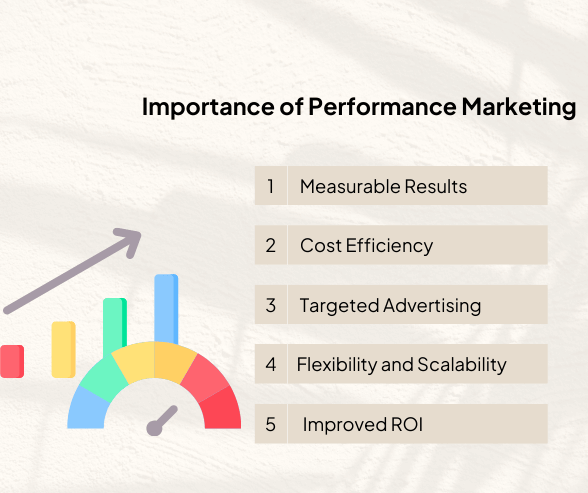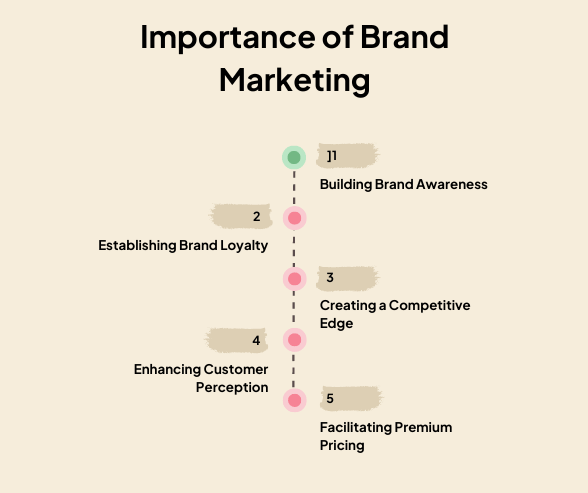Performance marketing vs brand marketing differ significantly in their approach and objectives. Performance marketing focuses on driving measurable actions and achieving specific, short-term goals such as clicks, conversions, sales, and leads. It relies heavily on data analytics, real-time metrics, and ROI tracking to optimize campaigns and ensure cost-effectiveness. On the other hand, brand marketing aims to build long-term brand equity, awareness, and loyalty. It emphasizes creating a strong brand identity, emotional connection, and positive perception through consistent messaging, storytelling, and engaging content across various channels. While performance marketing is highly results-driven and tactical, brand marketing is more strategic, focusing on establishing a lasting brand image and reputation.
Table of Contents
What is Performance Marketing?
Performance marketing is a data-driven approach that drives specific actions and measures their effectiveness. This type of marketing is typically tied to measurable results such as clicks, conversions, sales, or leads. The primary objective of performance marketing is to achieve a high return on investment (ROI) by tracking and optimizing campaigns in real time.
Read in detail: What is Performance Marketing?
Importance of Performance Marketing

Performance marketing plays a crucial role in the modern digital marketing landscape, offering several significant benefits for businesses aiming to optimize their marketing efforts and achieve measurable results. Here, we explore the key reasons why performance marketing is essential:
1. Measurable Results
One of the primary advantages of performance marketing is the ability to measure results accurately. Every aspect of a performance marketing campaign can be tracked and analyzed, from clicks and impressions to conversions and sales. This data-driven approach allows marketers to understand what’s working and what’s not, enabling them to make informed decisions and optimize campaigns in real-time.
2. Cost Efficiency
Performance marketing ensures that you only pay for actual results, such as clicks, leads, or sales, rather than for exposure or impressions. This pay-for-performance model helps maximize ROI by minimizing wasted ad spend. Businesses can allocate their marketing budgets more effectively, ensuring that funds are directed toward the most successful and high-performing campaigns.
3. Targeted Advertising
Performance marketing allows for highly targeted advertising. Marketers can use detailed demographic, geographic, and behavioral data to reach specific audiences with tailored messages. This precision targeting increases the likelihood of engaging potential customers who are more likely to convert, thereby improving the overall effectiveness of marketing efforts.
Also Read: Biggest Performance Marketing Challenges & their Solutions
4. Flexibility and Scalability
Performance marketing campaigns are highly flexible and scalable. Marketers can quickly adjust budgets, creatives, and targeting parameters based on real-time performance data. This adaptability allows businesses to respond to market changes and consumer behavior dynamically. Additionally, successful campaigns can be scaled up rapidly to maximize impact and reach.
5. Improved ROI
By focusing on measurable actions and optimizing performance campaigns, businesses can achieve a higher return on investment. Performance marketing strategies, such as PPC advertising, affiliate marketing, and retargeting, are designed to deliver tangible results that directly contribute to revenue growth. This outcome-driven approach ensures that marketing efforts are aligned with business goals and financial objectives.
Key Components of Performance Marketing
- Pay-Per-Click (PPC) Advertising: Platforms like Google Ads and Bing Ads allow advertisers to bid on keywords and pay only when their ad is clicked.
- Affiliate Marketing: Partners or affiliates promote a business’s products or services and earn a commission for each sale or lead generated.
- Social Media Advertising: Targeted ads on platforms like Facebook, Instagram, and LinkedIn aim to drive specific actions, such as app installs or e-commerce purchases.
- Email Marketing: Automated campaigns designed to nurture leads and drive conversions through personalized email content.
- Retargeting Campaigns: Display ads that target users who have previously interacted with your website or app, encouraging them to complete a desired action.
Common performance marketing channels:
- Search engine marketing (SEM)
- Pay-per-click (PPC) advertising
- Affiliate marketing
- Email marketing
- Social media advertising
Case Study: Domino’s Performance Marketing
Domino’s effectively targets 18-35-year-olds in India through robust digital marketing. With a strong social media presence on Instagram, Facebook, Twitter, and YouTube, the brand uses relatable content and multi-language videos to engage users. A Friendship Day campaign featured strangers bonding over a slice of pizza, with an Instagram contest enhancing engagement. Email and SMS marketing handle order confirmations, OTPs, and promotions, while Google search ads and targeted ads on Facebook and Instagram drive traffic and promote offers. The innovative “Pizza Tracker” feature allows real-time order tracking, boosting customer experience and trust. Overall, Domino’s India successfully engages its audience and builds loyalty through comprehensive digital strategies.
Read More: A/B Testing vs Multivariate Testing
What is Brand Marketing?
Brand marketing focuses on building a strong, positive brand perception over time. Unlike performance marketing, which aims for immediate, measurable actions, brand marketing seeks to create a lasting emotional connection with the audience. The ultimate goal is to enhance brand awareness, loyalty, and overall market presence.
Importance of Brand Marketing

Brand marketing is a foundational aspect of a successful business strategy. It goes beyond immediate sales and focuses on building a strong, positive, and lasting perception of a brand. Here are several key reasons why brand marketing is crucial for any business:
1. Building Brand Awareness
Brand marketing helps create and increase awareness of a brand among target audiences. By consistently communicating the brand’s values, mission, and unique selling propositions through various channels, businesses can ensure that their brand becomes recognizable and memorable. High brand awareness leads to greater customer recall and preference.
2. Establishing Brand Loyalty
Effective brand marketing fosters loyalty among customers. When consumers connect with a brand on an emotional level and trust its products or services, they are more likely to become repeat customers. Brand loyalty is invaluable as it not only leads to recurring revenue but also turns customers into brand advocates who promote the brand through word-of-mouth.
Read more: Top Performance Marketing Tools
3. Creating a Competitive Edge
In a crowded marketplace, strong brand marketing can set a business apart from its competitors. A well-defined and well-communicated brand identity makes it easier for consumers to choose one brand over another. This differentiation is crucial for businesses aiming to maintain a competitive edge and attract a loyal customer base.
4. Enhancing Customer Perception
Brand marketing shapes how customers perceive a brand. By consistently delivering on promises and maintaining high standards of quality and service, businesses can cultivate a positive reputation. This favorable perception can lead to increased customer trust and a stronger market position.
5. Facilitating Premium Pricing
A strong brand can command higher prices for its products or services. Consumers are often willing to pay more for brands they perceive as superior in quality, reliability, and value. Effective brand marketing reinforces these perceptions, allowing businesses to maintain premium pricing strategies without losing customers to competitors.
Read More: Performance Marketing vs Paid Advertising
Key Components of Brand Marketing
- Content Marketing: Creating valuable, relevant content that resonates with the target audience and reinforces the brand’s message.
- Social Media Engagement: Building a community around the brand through consistent, meaningful interactions on social media platforms.
- Public Relations (PR): Managing the brand’s reputation and public image through media coverage, press releases, and events.
- Sponsorships and Partnerships: Associating the brand with popular events, influencers, or other brands to increase visibility and credibility.
- Visual Identity: Developing a consistent brand identity, including logos, color schemes, and overall design aesthetics.
Common brand marketing channels:
- Public relations (PR)
- Content marketing
- Social media (brand building)
- Event marketing
- Traditional advertising (TV, radio, print)
Case study – Zoom: Connecting the World Through Video Communications
Zoom, founded by Eric Yuan in 2011, emerged as a pivotal platform for video communications, particularly during times of global upheaval. It quickly became a leader in video conferencing, webinars, and collaboration by prioritizing user experience with its simple interface, consistent quality, and reliability. Zoom catered to various market segments, from businesses and educational institutions to healthcare, and expanded globally through localization and strategic partnerships. During the COVID-19 pandemic, it offered free access to schools, scaled its infrastructure, and enhanced security to meet surging demand. Despite facing challenges like security concerns and intense competition, Zoom significantly impacted work culture and social interactions, and set new standards for video communication.

Also Read: Online Performance Marketing Training
Performance Marketing vs Brand Marketing – Key Differences
1. Goals and Objectives
- Performance Marketing: The primary goal is to drive immediate, measurable actions such as clicks, sales, or leads. Success is determined by ROI and conversion rates.
- Brand Marketing: The goal is to build long-term brand equity and emotional connections with the audience. Success is measured by brand awareness, loyalty, and overall perception.
2. Time Frame
- Performance Marketing: Focuses on short-term results. Campaigns are often designed to generate quick wins and are continually optimized based on performance data.
- Brand Marketing: Emphasizes long-term growth. Building a strong brand identity takes time, and the impact of brand marketing efforts may not be immediately visible.
3. Measurement and Analytics
- Performance Marketing: Relies heavily on data and analytics to track and optimize campaigns. Key performance indicators (KPIs) such as cost-per-click (CPC), cost-per-acquisition (CPA), and return on ad spend (ROAS) are commonly used.
Read more: Difference Between ROAS and Blended ROAS
- Brand Marketing: While brand marketing can also be measured, the metrics are often more qualitative. Brand sentiment, share of voice, and customer loyalty are some of the indicators used to assess success.
4. Budget Allocation
- Performance Marketing: Budgets are typically allocated based on expected ROI. Marketers may shift funds between campaigns and channels to maximize performance.
- Brand Marketing: Budgets are often fixed and allocated to maintain a consistent presence over time. Investment in brand-building activities is seen as a long-term commitment.
Integrating Performance and Brand Marketing
While performance marketing and brand marketing have distinct differences, they are not mutually exclusive. The most successful marketing strategies often integrate both approaches to create a balanced and comprehensive plan.
How to Balance Both Approaches
- Unified Strategy: Develop a cohesive marketing strategy that incorporates both performance vs brand marketing elements. This ensures that all efforts are aligned with the overall business goals.
- Consistent Messaging: Maintain consistent messaging across all channels and campaigns. Whether driving immediate actions or building brand equity, the brand’s voice and values should remain uniform.
- Data-Driven Insights: Use data and analytics to inform both performance vs brand marketing efforts. Insights from performance marketing can help refine brand strategies, while brand awareness metrics can guide performance campaigns.
- Flexible Budgeting: Allocate budgets dynamically, allowing for flexibility to invest more in either performance or brand marketing based on current needs and market conditions.
- Holistic Measurement: Combine quantitative and qualitative metrics to get a full picture of marketing effectiveness. Track short-term performance metrics alongside long-term brand health indicators.
Conclusion
Understanding the differences between performance marketing vs brand marketing is essential for crafting an effective marketing strategy. Performance marketing focuses on driving immediate, measurable actions, while brand marketing aims to build long-term brand equity and emotional connections with the audience. By integrating both approaches, businesses can achieve a balanced strategy that drives short-term results and long-term growth.
For those looking to excel in the dynamic field of performance marketing, Young Urban Project offers the best performance marketing course online. Their comprehensive program covers all aspects of performance marketing, from strategy development to data analysis, ensuring you gain the skills and knowledge needed to drive impactful marketing campaigns. With expert instructors, interactive sessions, and practical assignments, Young Urban Project equips you to master performance marketing and achieve outstanding results for your business or career.

